Metrail Test Track Photo Essay
Photos and comments by Kim Pedersen

New ideas are a dime a dozen. Here at the Monorail Society we continue to receive communications from companies that make great claims about their new designs. More often than not, these new designs don't get beyond conceptual drawings and promotional websites. When we first learned of Metrail, it came as quite a surprise. The Metrail Website debuted without warning and had pictures of a full-scale test track in operation, which caused quite a stir. Monorail technology continues to advance! Metrail is a design from the engineering solutions company, Frazer-Nash of the United Kingdom. Since World War II, Frazer-Nash has been on the cutting edge of high technology in a number of disciplines. The Metrail Monorail is an outgrowth of their wealth of knowledge and experience in electric vehicle development. On October 18, 2002, Metrail Holdings entered into agreement with Malaysia Mining Company Berhad (MMC) to design and build a monorail system. In February of 2004, David M. Ice and I were graciously hosted at the test track, located at a MMC facility in Nilai, Malaysia. (photo by David M. Ice)

The Metrail Monorail train has something that most monorails don't, a fuel cap and diesel engine! Frazer-Nash has found a way for smaller cities to build monorails without investing an extraordinary amount of money: the Hybrid-powered monorail.
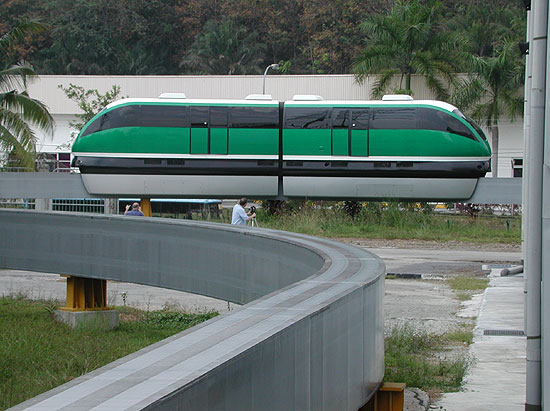
Being hybrid-powered, the Metrail system doesn't require a huge investment in electrical infrastructure. No substations, no busbars, no worries of power outages. Here we see the prototype train pulling out of its garage. The curve in the foreground demonstrates another advantage of the Metrail system, a minimum curve radius of 20 meters. We believe this is a tighter curve than any other monorail of this size can provide.
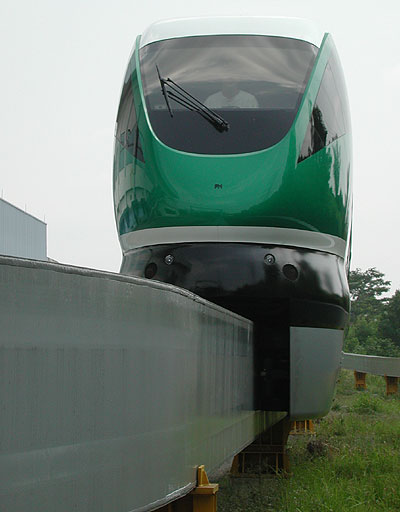
Frazer-Nash not only developed unique technology for their diesel/electric monorail, they have proven that a tall, flat floor, walk-through train can be designed to look beautiful. The driver pictured is yours truly (a very happy man, indeed!). The panel is right out of Star Trek, with touch screens to monitor every aspect of the monorails' systems.
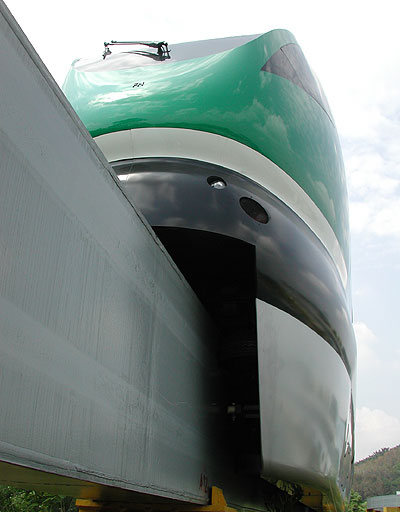
Up close and personal! The train was NOT in motion when this was taken. Since this is a test track facility, most of the guideway is very close to ground level, allowing a close look at the train/track partnership.
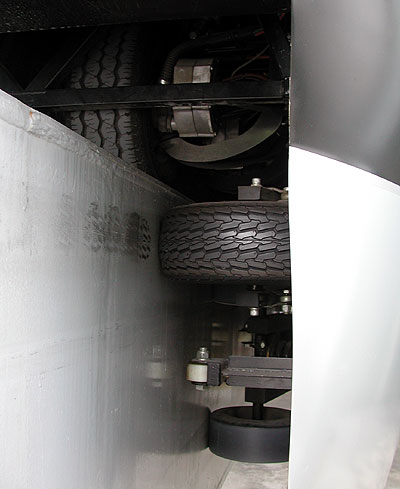
This is all we can show you of the bogie at this time. I can't tell you much, other than it is an entirely new design that incoporates coil and shock, double wishbone suspension, with six small, load-bearing tires on each bogie. This configuration allows for a very smooth ride and the amazing turn radius. The smaller tires also allow for a lower floor than some other flat-floor monorails.
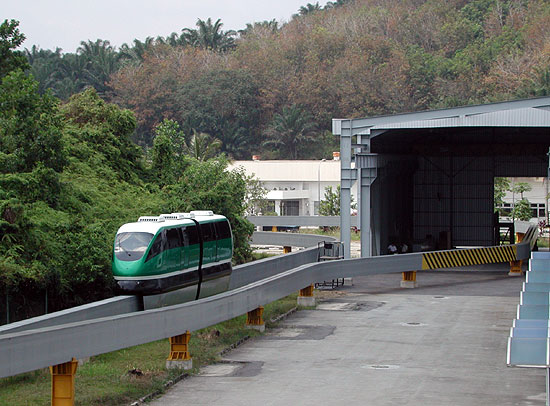
We climbed up to the roof of a nearby building to get this picture of one end of the test track. The guideway is steel, which was used because it was possible to build the test track quickly. When a transit system is built using Metrail, the guideway can be built using pre-stressed concrete or steel.
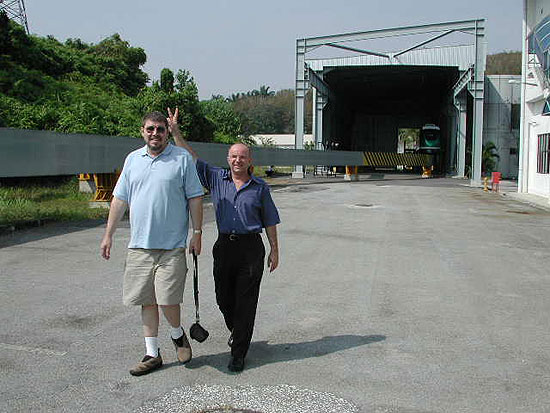
Here's David being being escorted by our host, Gordon Dixon, Director for Regional Operations for Frazer-Nash. Despite having a little fun here with David, Gordon went way beyond the call of duty hosting us on our visit to Malaysia. We are forever in debt to him for two visits to the Nilai facility, a tour of Putra Jaya, Malaysia's new capitol, and a wonderful dinner to celebrate David's 50th birthday. David was treated to a monorailist's dream on his actual 50th birthday by getting to drive the Metrail train around the entire circuit. Here we are walking out to the opposite end of the track loop to take some pictures and video.
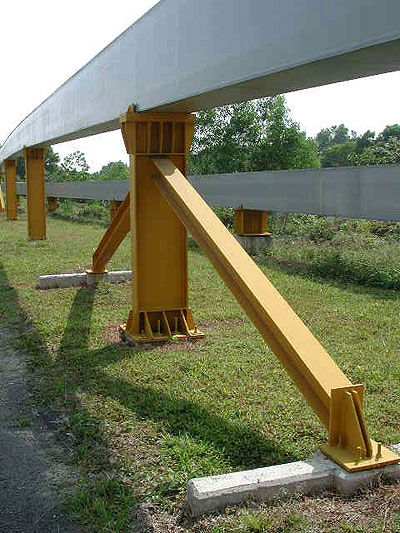
Along our walk we were able to inspect the steel columns that support the test track. Side bracing like this would be unneccesary on an urban application of Metrail. Note the lack of any electrical hardware, which cuts down on time required to build a guideway.
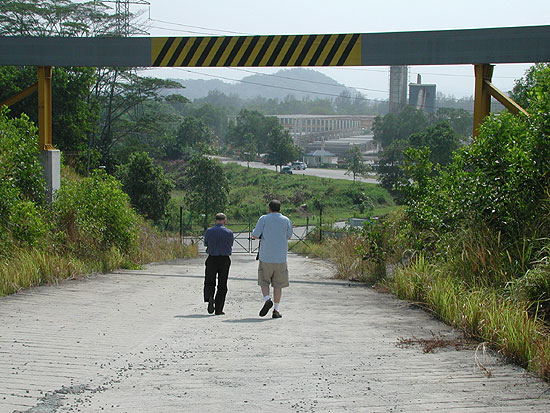
At the far end of the loop is the highest portion of the track, and a great spot for picture taking.
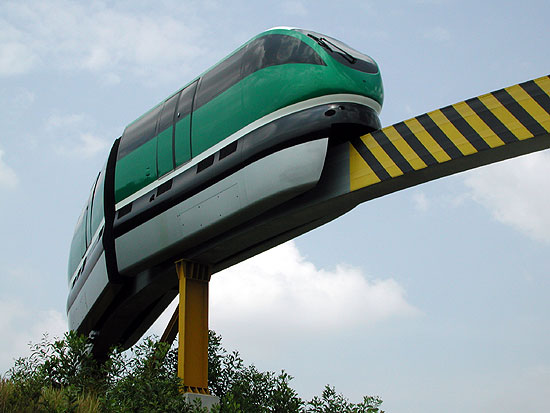
Gordon communicated to the technicians to bring the train around and we got something we don't normally get while documenting monorails for video, a train on demand! In fact, they even backed the train up so we could get a second shot.

Here's the same high point of the track, as seen from the roof top.

One of the concerns I had about a hybrid monorail was what would the noise factor be? What about those diesel engines? I paid close attention to the sound of the train throughout our visit and I can say without hesitation, excess noise is NOT a factor. The train creates about the same amount of sound under diesel power and it does under pure electrical power, which is minimal. Like other monorails, the low-decibel hum of air conditioners is usually what you hear when the train passes. I must add that those air conditioners were quite welcome in the sweltering, humid heat of Malaysia.
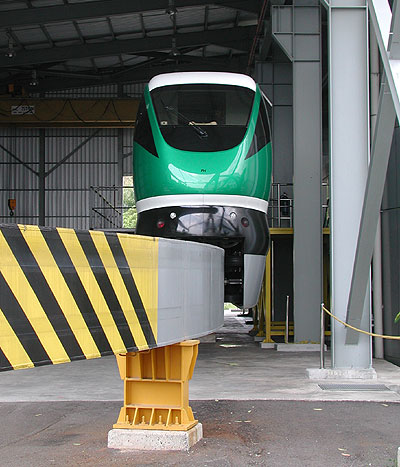
A beautiful train, back at its parking spot. This Metrail configuration consists of cars and track very similar in size to that of a Bombardier M-VI, however more space is available inside because of the flat floor configuration above the bogies, with the walk-through capability.

Above is a diagram of the Metrail Standard, which is what the test track has. The Metrail Standard has a capacity of five to ten thousand passengers per hour, suitable for resorts or smaller city duty.

The Metrail Plus is a longer train designed for regular city service of ten to twenty thousand passengers per hour.

At the top of the spectrum, Metrail has a larger car monorail on the drawing boards, the Metrail Ultra. This train for high-volume operations of thirty to forty thousand passengers per hour. The Minimum curve radius for Metrail Ultra is 45 meters. (drawings courtesy of Metrail)
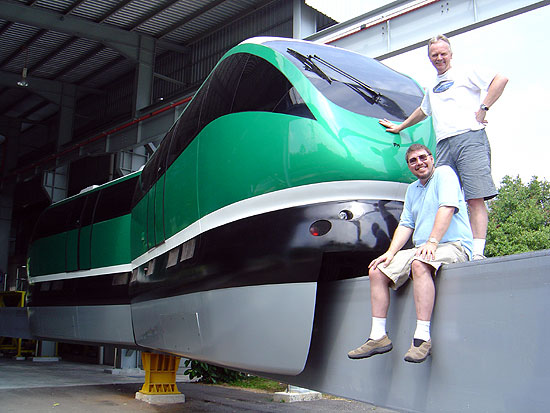
Don't try this at home, kids! Gordon got this nice photo of us on the guideway, taken for scale reference (photo courtesy of David M. Ice). The white stripe indicates the approximate location of the floor level. Our sincere thanks to Gordon and all the fine folks at Frazer-Nash and Metrail for showing off their promising new technology.
Photographs are copyright 2001 the Monorail Society unless noted otherwise.
